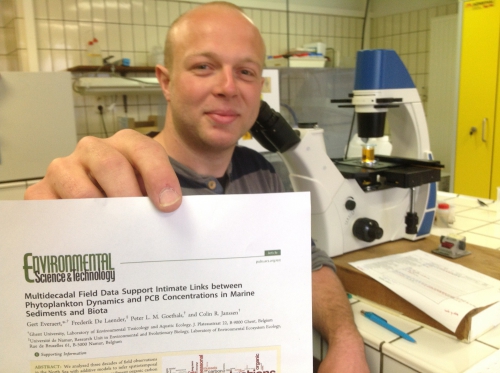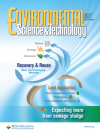Gert awarded SETAC Europe Best Paper prize
 Many congratulations to Dr. Gert Everaert of GhEnToxLab who is awarded the prize for the SETAC Europe Best Paper in the category of Chemical Analysis and Environmental Monitoring for his paper: "Multidecadal Field Data Support Intimate Links between Phytoplankton Dynamics and PCB Concentrations in Marine Sediments and Biota”. In this publication, Gert and his co-authors performed meta-analyses on existing monitoring data and found evidence that the biological pump plays a key role in the partitioning of PCBs between different marine compartments in the North Sea. One of the main strengths of the research is the uniquely large spatiotemporal scale on which the conclusions are based. The award ceremony will be held at the opening ceremony of the SETAC Europe Conference in Nantes on May 22nd 2016.
Many congratulations to Dr. Gert Everaert of GhEnToxLab who is awarded the prize for the SETAC Europe Best Paper in the category of Chemical Analysis and Environmental Monitoring for his paper: "Multidecadal Field Data Support Intimate Links between Phytoplankton Dynamics and PCB Concentrations in Marine Sediments and Biota”. In this publication, Gert and his co-authors performed meta-analyses on existing monitoring data and found evidence that the biological pump plays a key role in the partitioning of PCBs between different marine compartments in the North Sea. One of the main strengths of the research is the uniquely large spatiotemporal scale on which the conclusions are based. The award ceremony will be held at the opening ceremony of the SETAC Europe Conference in Nantes on May 22nd 2016.
In zijn onderzoek voerde postdoctoraal onderzoeker Gert Everaert meta-analyses uit op bestaande data over fytoplankton en de concentratie van pcb's (polychloorbifenylen) in de Noordzee. Hij ontdekte dat de zogenaamde biologische koolstofpomp, een proces waarbij fytoplankton koolstofdioxide opslaat in de zee, een grote rol speelt bij het ‘reguleren’ van de PCB-concentraties in de verschillende milieucompartimenten.

Scientific abstract
 We analyzed three decades of field observations in the North Sea with additive models to infer spatiotemporal trends of chlorophyll a concentration, sediment organic carbon content, and polychlorinated biphenyls (PCBs) concentrations in mussels and sediments. By doing so, we separated long-term changes in PCB concentrations from seasonal variability. Using the inferred seasonal variability, we demonstrated that phytoplankton blooms in spring and autumn correspond to the annual maxima of the organic carbon content (r = 0.56; p = 0.004) and the PCB concentrations in sediments (r = 0.57; p = 0.004). Furthermore, we found a negative correlation between the PCB concentrations in sediments and in blue mussels (Mytilus edulis; r = −0.33, p = 0.012), which is probably related to the cleansing of the dissolved PCB phase driven by sinking organic matter during phytoplankton blooms and the filter-feeding behavior of the blue mussel. The present research demonstrates the role of seasonal phytoplankton dynamics in the environmental fate of PCBs at large spatiotemporal scales.
We analyzed three decades of field observations in the North Sea with additive models to infer spatiotemporal trends of chlorophyll a concentration, sediment organic carbon content, and polychlorinated biphenyls (PCBs) concentrations in mussels and sediments. By doing so, we separated long-term changes in PCB concentrations from seasonal variability. Using the inferred seasonal variability, we demonstrated that phytoplankton blooms in spring and autumn correspond to the annual maxima of the organic carbon content (r = 0.56; p = 0.004) and the PCB concentrations in sediments (r = 0.57; p = 0.004). Furthermore, we found a negative correlation between the PCB concentrations in sediments and in blue mussels (Mytilus edulis; r = −0.33, p = 0.012), which is probably related to the cleansing of the dissolved PCB phase driven by sinking organic matter during phytoplankton blooms and the filter-feeding behavior of the blue mussel. The present research demonstrates the role of seasonal phytoplankton dynamics in the environmental fate of PCBs at large spatiotemporal scales.
Full reference (link)
Everaert G, De Laender F, Goethals PLM, Janssen CR. 2015. Multidecadal Field Data Support Intimate Links between Phytoplankton Dynamics and PCB Concentrations in Marine Sediments and Biota. Environmental Science and Technology 49 (14), 8704 – 8711.
